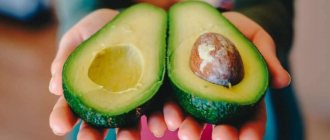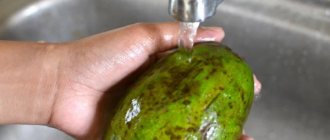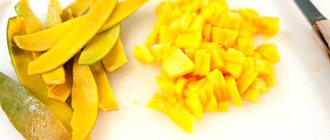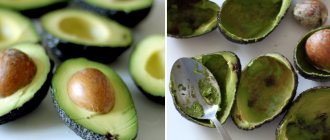Visually and “tactually” assessing the degree of ripeness of an avocado in a store is sometimes quite difficult. The taste of unripe fruits leaves much to be desired; their flesh is hard, almost devoid of aroma. How to ripen avocados at home sometimes becomes a pressing question.
At the same time, you often have to choose between speed and maintaining the quality of the fruit - the faster the process of “forced” ripening goes, the more the benefits and taste suffer. All the popular “life hacks” described in the article can be easily repeated on your own.
No special skills or equipment are required for this.
"Warming up" in the microwave
The method is most relevant if you need to make a ripe avocado urgently. The process takes from 20-30 seconds to 2-3 minutes, depending on the initial degree of ripeness and varietal characteristics (in particular, skin density).
The procedure is extremely simple:
- Pierce the peel in 2-3 places with a fork. If this is not done, the fruit may simply explode during “warming”, even for a short time.
- Place the fruit on a metal or glass “tray” and cover with a lid.
- Microwave on medium power for 30 seconds.
- Evaluate the result by lightly squeezing the fruit. If the flesh comes under your fingers but there is no dent in the skin when they are removed, it is ready to eat.
- Continue “warming” in the microwave in short bursts of 10-15 seconds, each time assessing the condition of the pulp.
- Allow the fruit to cool to room temperature. Peel and cut as required by recipe.
You must immediately take into account that the taste of fruits processed in this way will not be ideal, even if everything is done correctly. Many nuances and shades are lost, the “herbaceous”, “nutty”, “coniferous” and “fresh” notes for which gourmets value them.
However, for “multi-component” salads, sauces, smoothies, sushi, and sandwiches, avocados “warmed up” in the microwave are quite suitable. It’s even better if the recipe includes additives that “mask” and “complement” the main taste:
- salt;
- pepper;
- fresh herbs;
- any spices;
- vegetable oils.
The benefit practically disappears after “warming up” in the microwave. Vitamins, macro- and microelements are inevitably destroyed during heat treatment.
Signs of a ripe avocado
Unripe avocados are not harmful to human health. It is no less healthy than ripe fruit, but less pleasant to the taste.
Ripeness is determined by:
- Blossom. In a ripe avocado, it is bright green, closer to emerald. If the fruit has a brownish tint, it means it is overripe; if it is light green, it is not ripe. It is worth considering that there are varieties that are characterized by a dark green, almost black tint.
- The peduncle. The hole under the stalk of a ripe fruit is light green, that of an unripe fruit is yellow, and that of an overripe fruit is brownish.
- The bone. It should separate easily from the pulp. If this is not the case, it means the fruit is not ripe.
- Softness. The ripe fruit is soft to the touch. If you press on it, the dents left by your fingers will quickly straighten out. Green avocado will not squash when pressed. Overripe is too soft and easily deformed.
- Aroma. If you smell the ripe fruit, you can feel a light characteristic aroma. An unripe avocado has no distinct odor.
"Baking" in the oven
A method in many ways similar to the previous one, and with similar disadvantages. Here, too, the benefits and taste suffer significantly. The process takes a little longer - up to 8-10 minutes.
How to proceed:
- Wash the avocado, wipe it dry or let it dry naturally.
- Pierce the peel in 2-3 places with a fork.
- Wrap each fruit in aluminum foil, leaving no “gaps” (in several layers if necessary).
- Place the fruit on a baking sheet or in a baking dish. Place in an oven preheated to 200-210°C.
- Check by touch how much the pulp has softened. If necessary, return to the oven for another 1-2 minutes.
- Allow the fruits to cool completely, only then remove the foil.
A slower, but also “gentler” method is “baking” at a temperature of 80-90°C for 30-35 minutes.
Read: Top 37 exotic fruits in 2022
Techniques for accelerating avocado ripening
If unripe fruits were purchased, the question arises of what and where to put the avocado so that it ripens faster. There is no need to throw away cut fruits: there are several methods to add juiciness to tough pulp. How to quickly ripen an avocado:
- cut the fruit;
- remove the bone;
- cut the halves of the fruit into slices and place them in a plastic bag;
- put in the refrigerator.
It is recommended to store the slices on the top shelves or in the vegetable compartment. After 40-48 hours the fruit will become softer. Another way:
- cut the avocado into 2 halves;
- remove the pit;
- sprinkle the fruit with fresh lemon juice;
- connect the halves together;
- wrap the fruit in cling film.
Alligator pear can also be stored pureed in the refrigerator. It is impossible to subject the pulp to preliminary heat treatment (cooking, simmering in boiling water): the taste will be lost. It is necessary to remove the skin from the unripe fruit, cut the pulp into small slices and grind in a blender. The resulting mass can be placed in plastic molds and sprinkled with lemon juice. Keep in the freezer for several days.
The skin of unripe fruits contains a large number of toxins that are dangerous to the human body. Some of them absorb pulp, so eating unripe fruit can cause severe poisoning.
In the oven
Without the use of electrical appliances designed to heat food, the ripening process can take several days. The fruit will ripen much faster in the oven or oven. This method is suitable if you need to prepare a dish from an alligator pear in the near future.
Thanks to even heat, the pulp will become juicy in a few minutes.
The fruit may taste slightly different after heating in the oven. You can use them to make guacamole, smoothies or fruit salad. How to help ripen an avocado:
- rinse the avocado under running water;
- wipe it with a paper towel;
- use a fork or skewer to make several punctures on all sides (especially at the base);
- Line a baking sheet with parchment paper, place the fruit on it and place in a preheated oven.
It is necessary to remove the iron sheet after 7-10 minutes. The oven should be preheated to 180-200° C. If you increase the temperature, the avocado will become dry and the flesh will acquire a bitter taste.
In the microwave
An avocado will ripen in a few minutes in the microwave. The effect is achieved thanks to electromagnetic waves that evenly heat the fruit from all sides. Many people make the mistake of choosing the wrong container for the microwave oven: using aluminum, nickel-plated and plastic utensils is strictly prohibited. A ceramic or porcelain plate is suitable for these purposes.
Avocados should be washed with warm water to remove dust and other contaminants and wiped with a napkin. Make punctures to ensure air circulation inside the fetus. You can carefully cut the fruit (strips, no more than 1 mm deep). Place the alligator pear on a plate and cover with a napkin, otherwise the avocado will burst under the influence of temperature.
Set a timer on the microwave for 25-30 seconds. If the fruit does not become soft, the procedure is repeated several times. It is not recommended to heat it in the microwave for more than 30 seconds - it is best to do several approaches. Reviews about the method are quite contradictory: many believe that after heating an avocado in the microwave, the flesh becomes bitter and dry, and most of the nutrients are destroyed.
We recommend that you read Life expectancy of spruce
In the package
Unripe fruits can be stored in plastic or paper bags, either whole or sliced. The material of the container directly determines where to store avocados. Small amounts of ethylene begin to accumulate inside hermetically sealed bags - the gas accelerates ripening, so it is better to pack fruit in disposable transparent containers with a zip fastener.
Paper bags help speed up the ripening of the fruit by retaining moisture inside it. You can store any fruit with avocado: alternate alligator pear slices with banana or apple slices. The fruit slices are laid out in one layer, the bag is closed, releasing the air from it. The container should be kept in the room, avoiding direct sunlight. It is not recommended to put it in the refrigerator.
The optimal storage temperature is no more than 24° C. You need to periodically check the contents by feeling the package 2-3 times a day. If some slices have darkened, they are removed. If the fruit is “adjacent” to pieces of pineapple or banana, it will fully ripen in 3-4 days.
Using a newspaper
If you don't have a plastic bag on hand, you can wrap the avocado in newspaper. Despite the fact that printing production uses low-toxic inks, for these purposes it is preferable to use paper with black printing. Colored paint contains metal salts (iron, cobalt, aluminum, lead) that are dangerous to the body. The ink's durability is poor; tiny particles can remain on the skin of the avocado.
How to make an avocado ripe using newspaper:
- rinse the fruit and dry it thoroughly;
- wrap each fruit in newspaper;
- put the fruit in a warm, dark place.
Cut slices should not be wrapped in newspaper. During the ripening process, a large amount of juice is released, the paper becomes wet, the ink spreads and penetrates into the fruit. The same thing happens if you wrap the fruit in newspaper immediately after washing without wiping it. The fruit ripening period is several days.
Avocados wrapped in paper should not be stored in the sun or in the refrigerator. It should be left to ripen in a well-ventilated area at room temperature. Fruits ripened in this way do not lose their taste and smell and can be eaten immediately.
We recommend that you read Drying tangerines for decoration
In foil
To ripen, avocados are wrapped in aluminum foil. In the oven, you can achieve softness of the fruit in a few minutes. Preparing the fruit:
- rinse the avocado under running water (you can use soap);
- dry the fruit by placing it on a paper towel;
- make several cuts or punctures (with a skewer or fork).
The cuts should be shallow. It is best to wrap the fruits in several layers of foil - the more there are, the faster ethanol will begin to release. The oven is preheated to 200° C, the fruit is placed on an iron sheet and placed in the oven for 7-10 minutes. If the slices were wrapped in foil, the temperature and holding time are reduced (at 160-180 ° C, 5-6 minutes).
In 3-5 days, avocados wrapped in 2-3 layers of foil ripen at room temperature. In this case, it is not necessary to cut the fruit. The storage place should be dark and warm. Direct sunlight and moisture will slow down the ripening process. Avocados are also not stored in the refrigerator.
Fruits ripened in foil do not lose their juiciness. The pulp does not lose its taste, nutrients are retained in full.
In boiling water
If the avocado is unripe, and you need to add it to the dish as quickly as possible, you can use the old method - immerse the fruit in hot water. This method is considered an instant ripening method. Only green varieties of avocados can be placed in boiling water; black fruits become bitter.
The water is brought to a boil and allowed to cool slightly (to 75-80° C). Remove the skin from the fruit and cut it in half. Remove the bone with a spoon and cut the pulp into thin bars. The slices must be spread out in a thin layer on gauze folded in several layers and immersed in hot water for 2-3 minutes. It is recommended to squeeze out excess liquid. To make the fruit softer, you can add a little honey to the water.
The alligator pear slices must cool completely or the fruit will taste watery. After the excess liquid has completely drained, the gauze is unrolled, straightened and the slices are separated from each other. At room temperature, the pieces cool for 10-15 minutes, after which they can be added to the dish.
“Cooking” in boiling water
Like other methods involving heat treatment, it does not allow to fully preserve the taste and beneficial properties. But it allows the fruits to ripen quickly - in 6-8 minutes.
The process is simple:
- Prick the avocado several times with a fork or make shallow cross-shaped cuts at the base and stem.
- Place the fruits in a sufficiently large bowl or saucepan.
- Pour boiling water over until it completely covers them.
- Remove the fruits (any available means should help here), and evaluate their softness. If the flesh remains hard, immerse them in boiling water again for another 2-3 minutes, changing the water.
To reduce heat treatment time, it is peeled and cut into thin (5-8 mm) plastics. They are placed in a colander and dipped in boiling water. The richness of flavor will inevitably suffer, but you can get by with 3-4 minutes.
Method 5: Avocado in newspaper
Despite the fact that this is one of the oldest methods, it is still used by many housewives.
Method:
- Wrap the unripe fruit in a sheet of newspaper and place it in a warm place, for example, in a still hot oven (turned off).
- Leave it for a couple of days or until it becomes soft.
Now you know how to speed up the ripening of an avocado if you bought it unripe but want to eat it as soon as possible.
Choose the method that you like best and follow our instructions step by step to get good and fast results. published
PS And remember, just by changing your consumption, we are changing the world together! © econet
"Waiting" on paper
The method is sometimes called “grandfather’s” or “grandmother’s”. Although the fact that grandparents living in the USSR were familiar with avocados raises reasonable doubts.
The procedure allows you to preserve all the nuances of taste and nutrients to the maximum, but it takes time. The process takes from 2-3 to 5-7 days, depending on the initial ripeness of the fruit.
The main thing is that the paper is not glossy or waxed. A regular piece of paper or an old newspaper will do.
The washed and dried fruits, one at a time, are tightly wrapped in 2-3 layers of paper and simply left warm, for example, near a radiator, on a kitchen cabinet, or in the summer - on a south or east windowsill (but not in direct sunlight).
The change in the condition of the fruits is monitored once a day, periodically turning them from one side to the other so that the “processing” proceeds evenly. Once the flesh has softened enough, they are ready to eat.
It is necessary to think about “protection” from “encroachments” by domestic animals. Unripe fruits contain persin. This substance will not harm human health, but for pets it can be dangerous, and in large doses it can even be “deadly.”
Useful properties of avocado
This fruit with oily pulp is a storehouse of healthy vitamins and minerals. It is suitable for both underweight people and larger people who want to lose weight. Contains a lot of iron, potassium, phosphorus, selenium and other elements.
Recommended:
- for problems of the gastrointestinal tract;
- to strengthen the immune system;
- used as an aphrodisiac and to improve potency;
- Regular consumption relieves women from pain during menstruation.
When it has not reached ripeness, it tastes like pumpkin; when fully ripe, it evokes different associations in people; for some it resembles butter with the addition of nuts, for others it resembles fried chicken, for others it resembles fried zucchini.
“Help” from other fruits
The ripening of any fruit is accelerated by ethylene gas. It is intensively produced by already ripe and overripe fruits.
At the same time, the “consumer properties” of avocados do not suffer in any way; the benefits are retained in full.
The process takes on average 2-3 days, but the exact time is impossible to determine. Its duration depends on:
- the initial ripeness of the avocado;
- activity of “auxiliary” fruits in terms of ethylene release;
- optimal microclimate in the room.
The procedure is extremely simple:
- Place the washed and dried fruits in a whole plastic or paper bag. Reusable packaging with a zipper or a plastic container that provides maximum airtightness is best. One “helper” is enough for 3-4 avocados.
- Ensure a constant room temperature within 20-24°C.
- Check ripeness daily.
When choosing what to put an avocado in one bag with, you need to take into account that the “champions” in ethylene synthesis are:
- bananas;
- red apples;
- tomatoes.
In order for it to ripen faster, you should not put any rotting fruit in the same bag with the fruit. They produce a minimum of ethylene, but actively spread pathogenic microflora; in a “closed space” infection occurs very quickly.
How to determine the ripeness of an avocado?
In the store you can buy avocados, both unripe and overripe. How to learn to choose an avocado? After all, it is better to take a green fruit than an overripe one and then throw it away.
Learning to determine the ripeness of an avocado:
- We take the avocado in the palm of our hand and squeeze it: the fruit is tight, which means it’s green; slightly pressed - ripe; soft - overripe.
- Avocados have bright green, shiny skin - green; the fruit is dark green, faded - mature; Brownish spots have appeared on the fruit - it is overripe.
- The avocado has a green stalk - the fruit is unripe; slightly darkened - ripe; dark brown to black – overripe.
- An unripe avocado will ripen, just choose one that is not wilted - this one will not be able to ripen.
- Overripe avocados are not suitable for food.
Avocado ripeness
Here's how to tell if an avocado is ripe
“Preservation” in cling film
If the unripeness of the avocado becomes apparent only after cutting it, you must:
- Remove the bone.
- Spray the cut with lemon juice or citric acid diluted in water to prevent the flesh from darkening and spoiling. If the fruit has already been cut into small pieces, place them in a bowl and mix gently so that the lemon juice covers them as evenly as possible, but the pulp does not turn into “porridge”.
- Connect the halves and, if possible, wrap them tightly and airtight with cling film in 2-3 layers. The peeled and cut into pieces fruit is wrapped in one common “bag”, after releasing the oxygen.
- Place the avocado in the refrigerator, in a special compartment where vegetables and fruits are stored, for at least two days. The process may take longer, but no more than 4-5 days.
The condition of the fetus is monitored daily without compromising the integrity of the packaging. If the pulp and peel begin to darken, it should be consumed immediately, regardless of the degree of ripeness, or thrown away.
Quickly soften avocados for salads and dishes
Artificial ripening through heat distorts the taste and aroma of avocados. If in its normal state it is distinguished by a delicate fruity sweetness with a nutty flavor, then after forced ripening the pulp almost always becomes less tasty. If you hold the fruit for even a couple of seconds, it may lose its taste and become bitter. Therefore, when warming up, wherever it happens, it is important not to overdo it with time and not to repeat this procedure unless absolutely necessary. An overripe avocado is unsuitable for eating in any form.
Moderately hard contents indicate that you can cut the fruit and put it in a dish. Avocado should not be equal in softness to a pear. But even a salad, guacomole or a milkshake with it can be ruined if you overcook the alligator pear at high temperatures.
Therefore, when choosing a way to ripen an avocado at home, it is still better to try to bring it to ripeness using a natural method. The “shock” option should be used as a last resort.
“Burying” into cereals
Certain grains, especially rice and corn, also produce ethylene.
An avocado will ripen in 1-3 days if you put it in a large container so that a layer of grain about 2-3 cm thick separates it from the bottom, top and walls.
The specific variety of rice does not matter in this case. It is only important that it is cleaned.
The process at room temperature goes quickly, so it is important to monitor the condition of the fruit daily.
In a paper bag with bananas
Avocados are placed in a craft packaging bag along with ripe bananas (you can also put apples and pears). The latter emit ethylene vapors, which accelerate ripening. And craft paper holds ethylene well. You can use a plastic bag, but check the contents often. At a temperature of +22–24 degrees, the avocado can ripen in a couple of days.
A way to quickly soften the fruit
Avocados usually take several days to ripen. If you urgently need fruit for a salad, you can use the microwave.
You can make avocados soft in just a few minutes:
- Using a fork, pierce the fruit on all sides. Place on a plate. Cover with a plastic lid. This is a mandatory condition, since without shelter the fruit may explode.
- Set the maximum mode and time to 30 seconds.
- If during this time it was not possible to soften the avocado, then heat for another 30 seconds.
Cool and use as usual.
How long does it take for an avocado to ripen at home?
The speed of vegetable ripening depends on the method chosen and the time you have. On average, it should take at least one or two days for natural readiness to be consumed.
Creating the necessary conditions does not guarantee one hundred percent ripening. In addition, avocados must be regularly monitored during the ripening process; often an apparently ripe forgotten vegetable turns out to be hopelessly spoiled and unsuitable for use in recipes and cooking.
Buy firm avocados a week before the day of intended preparation. But there is a suitable way for emergency situations.
Instant fruit ripening
Very soon, a ripe fruit will appear on your table, from which you can prepare a salad, puree, use it in desserts, in Japanese cuisine, or eat it as an independent dish.
It is important to note here that if you leave the fruit in the oven, it may slightly change its taste, so you need to approach this issue carefully and be prepared for such consequences.
How to store the fruit
When buying exotic, you need to realize that its storage conditions depend on several factors.
Whole and cut fruits retain their condition for different times. What matters is the degree of ripeness of the fruit and where the avocados are stored.
Ripe and green
Whole ripe or unripe fruits require different storage conditions.
- A container or compartment for vegetables and fruits in the refrigerator is suitable for ripe ones. The second option is a ziplock bag. After placing the fruit, the air is removed from it. The refrigerator will keep the ripe exotic fruit for five to six days. This solves the problem of how to preserve a ripe avocado until the New Year. The fruit may lie on the table for a day or two.
- Unripe whole specimens are stored only at room temperature until they ripen. The refrigerator is not suitable - they will never be able to ripen there.
The fruit should not be kept open in the refrigerator: it will darken and absorb foreign odors.
With any storage method, you need to remember: the riper the exotic, the shorter its shelf life.
Avocado - an exotic delicacy
The fruit has a smooth creamy texture, a pleasant aroma, goes well with other foods, is a source of energy, and is high in fatty acids, proteins and antioxidants.
Attention! The only drawback is that it is difficult to understand whether the avocado has reached the right level of ripeness or not? Can it be eaten?
And all because it most often ends up on store shelves in an unripe form, because it is transported from distant countries. Now our task is to make it suitable for consumption.











